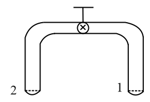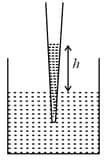MEDIUM
Earn 100
A glass tube of uniform internal radius r has a valve separating the two identical ends. Initially, the valve is in a tightly closed position. End 1 has a hemispherical soap bubble of radius r. End 2 has sub-hemispherical soap bubble as shown in figure. Just after opening the valve.


50% studentsanswered this correctly
Important Questions on Mechanical Properties of Fluids
EASY
EASY
EASY

MEDIUM
MEDIUM
EASY
HARD
MEDIUM
EASY
MEDIUM
EASY
HARD
If two glass plates have water between them and are separated by very small distance (see figure), it is very difficult to pull them apart. It is because the water in between forms cylindrical surface on the side that gives rise to lower pressure in the water in comparison to atmosphere. If the radius of the cylindrical surface is R and surface tension of water is T then the pressure in water between the plates is lower by:

EASY
HARD
MEDIUM
MEDIUM
EASY
EASY
HARD
MEDIUM
